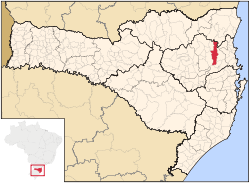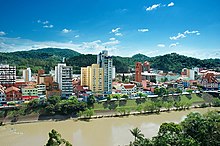Blumenau (Brazil)
| Município de Blumenau "Capital da Cerveja"
Blumenau
|
|||
|---|---|---|---|
|
|
|||
| Coordinates | 26 ° 55 ′ S , 49 ° 4 ′ W | ||

|
|||
| Symbols | |||
|
|||
|
Motto "Pro Sancta Catharina Et Brasilia" |
|||
| founding | September 2, 1850 | ||
| Basic data | |||
| Country | Brazil | ||
| State | Santa Catarina | ||
| ISO 3166-2 | BR-SC | ||
| Região intermediária | Blumenau (since 2017) | ||
| Região imediata | Blumenau (since 2017) | ||
| Mesoregion | Vale do Itajaí (1989 to 2017) | ||
| Microregion | Blumenau (1989 to 2017) | ||
| height | 21 m | ||
| climate | Cfa, subtropical | ||
| surface | 518.5 km² | ||
| Residents | 309,011 (2010) | ||
| density | 596 Ew. / km² | ||
| estimate | 352,460 (July 1, 2018) | ||
| Parish code | IBGE : 4202404 | ||
| Post Code | 89000-000 | ||
| Time zone | UTC −3 | ||
| Website | www.blumenau.sc (Brazilian Portuguese) | ||
| politics | |||
| City Prefect | Mário Hildebrandt (April 5, 2018–2020) | ||
| Political party | Partido Socialista Brasileiro (PSB) | ||
| economy | |||
| GDP | 10,927,079 thousand R $ 35,361 R $ per person (2012) |
||
| HDI | 0.806 (2010) | ||
Blumenau , officially Portuguese Município de Blumenau , is a city in the Brazilian state of Santa Catarina .
According to the 2010 census, the population was 309,011 people who are called Blumenauer or Portuguese Blumenauenses . The population estimate of July 1, 2018 according to the IBGE was growing to 352,460 residents in an area of 518.497 km². It ranks third of the 295 parishes in Santa Catarina.
geography
location
Blumenau is about 50 kilometers from the coast of the Atlantic between Joinville in the north and the capital Florianópolis in the south in the Itajaí valley . Due to the hilly environment and the river, the habitable area is very limited. As at the time of its foundation, the city still has to struggle with severe floods and high tides of up to 17.1 m.
climate
|
Average monthly temperatures and rainfall for Blumenau
Source: Climate-Data.org ;
|
|||||||||||||||||||||||||||||||||||||||||||||||||||||||||||||||||||||||||||||||||||||||||||||||||||||||||||||||||||||||||||||||||||||||||||||||||||||||||||||||||||||
The climate of Blumenau is subtropical . According to the Köppen and Geiger Cfa climate classification , the city has a warm, moderate rainy climate . Blumenau, like the entire state of Santa Catarina, is south of the tropic . Hence there are mild winters and warm, humid summers.
history
The city, which was founded in 1850 by German immigrants under the direction of the pharmacist Hermann Blumenau , is one of the three centers of German colonization in Santa Catarina , along with Joinville and Brusque . The half-timbered houses popular with many visitors (e.g. Prefeitura Municipal, Casa Moellmann) are mostly from the most recent times.
language
| Number of schools by language of instruction (1905) | |||||||
|---|---|---|---|---|---|---|---|
| German (only) | 81 | ||||||
| Italian (only) | 17th | ||||||
| German and Portuguese | 5 | ||||||
| German and Polish | 4th | ||||||
| Portuguese (only) | 4th | ||||||
| German and Italian | 1 | ||||||
| total | 112 | ||||||
For roughly the first 100 years after the colony was founded, German was the predominant language in Blumenau. It was initially used as the only language, as the first colonists came exclusively from Germany. With increasing immigration from other European countries and Brazilian internal migration, other languages (especially Italian and Polish) were also spoken in Blumenau. But they were limited to the respective immigrants. German was the lingua franca in Blumenau and the entire region. The German-speaking emigrants and their descendants had a good infrastructure of schools, clubs, theaters and similar facilities.
The table on the right gives an idea of the importance of German two generations after the colony was founded. It shows the number of schools in Blumenau according to the language of instruction.
With the policy of the Estado Novo (1937–1954) under the dictatorial powers of President Getúlio Vargas , a nationalization campaign was carried out in Brazil that also affected the German-speaking community, as the state forced the assimilation process. When Brazil entered World War II on August 22, 1942 on the side of the Allies , the situation for the German-speaking population worsened again. Schools that taught in German were closed, the use of the German language was banned and Portuguese also found its way into Blumenau. Although Portuguese is the predominant language in Blumenau today, German has been retained as a colloquial language in parts of the population.
Ethnic composition
Ethnic groups according to the statistical classification of the IBGE (as of 2010 with 309,011 inhabitants):
| group | Share (2010) | annotation |
|---|---|---|
| Brancos | 277.680 | Whites, descendants of Europeans |
| Pardos | 25.168 | Mixed ethnic groups, mestizos |
| Pretus | 4,838 | black |
| Amarelos | 961 | Asians |
| Indigenous people | 345 | indigenous population |
economy
Industries and companies
One of the most important branches of the economy is the textile industry. Among other things, the Hering company in Blumenau, founded by German immigrants in 1880 , primarily produces for the Brazilian market.
Furthermore, more and more companies from the information and communication sector have settled in the city in recent years. The Eisenbahn Brewery in Blumenau produces beer that is brewed in accordance with the German Purity Law and distributed throughout Brazil by the Schincariol Group.
In addition to tourism and the textile industry , the porcelain industry is another important economic area. In addition, the city is the most important financial center in the state of Santa Catarina.
tourism

An important economic sector for the city as well as for the entire region is tourism, the focus of which is on the range of German gastronomy and culture that is rather untypical for Brazil. In 1984, based on the Munich original, the first Oktoberfest was held in Blumenau . The reason for this was the need for funds for the necessary reconstruction measures after the great flood in 1983. In recent years, the festival has established itself as the second largest festival in Brazil after the carnival in Rio, with over 600,000 visitors . This has also increased the city's profile in Germany, which is also important in terms of tourism.
The buildings with half-timbered facades also contribute to the attractiveness. Haus Moellmann (picture), opened in 1978, is an enlarged replica of the town hall of Michelstadt in the Odenwald in Hesse, built in 1484 .
Diocese of Blumenau
Blumenau is the seat of a Roman Catholic diocese , which was founded on April 19, 2000 from areas of the Archdiocese of Florianópolis and the dioceses of Joinville and Rio do Sul.
Town twinning
-
 Campinas , Brazil
Campinas , Brazil -
 Petrópolis , Brazil
Petrópolis , Brazil -
 Bariloche , Argentina
Bariloche , Argentina -
 Osorno , Chile
Osorno , Chile -
 Macapá , Brazil
Macapá , Brazil -
 Posadas , Argentina
Posadas , Argentina -
 Frankenthal (Palatinate) , Germany
Frankenthal (Palatinate) , Germany -
 Weingarten (Württemberg) , Germany
Weingarten (Württemberg) , Germany -
 Covilhã , Portugal (cooperation agreement)
Covilhã , Portugal (cooperation agreement)
Personalities
sons and daughters of the town
- Theo Balden (1904–1995), sculptor
- Armin Zimmermann (1917–1976), General Inspector of the Bundeswehr
- Vera Fischer (* 1951), actress
- Wolfgang Fenske (* 1956), pastor, theologian and author
- Marcelo da Veiga (* 1960), founding rector of the Alanus University of Art and Society
- Ana Moser (* 1968), volleyball player
- Chris (* 1978), soccer player
- Rafael Schmitz (* 1980), soccer player
- Diego Viana (born 1983), football player
- Tiago Splitter (* 1985), basketball player
- Eduarda Amorim (* 1986), handball player
- Jardel Capistrano (* 1989), football player
- Renan Wagner (* 1991), football player
- Nathan (* 1996), soccer player
People associated with the city
- Hermann Blumenau (1819–1899), founder of the city
- Fritz Müller (1821–1897), nature observer and biologist
- Julius Scharlach (1842–1908), Hamburg lawyer and promoter of Blumenau's transport links to the South Atlantic
- Martin Drewes (1918–2013), German pilot and aviation author
literature
- Antonio B. Barreto and Alda S. Niemeyer: A valley calls for help. Debras Verlag 2004, ISBN 3-937150-00-5 , documentation of the flood in Blumenau from 1983.
Web links
- City Prefecture website , Prefeitura Municipal (Portuguese)
- Oktoberfest in Blumenau
- Impressions from Blumenau, S. C. - u. a. Memorial plaque to Hermann Blumenau
- The Blumenau Society e. V.
Individual evidence
- ↑ a b Instituto Brasileiro de Geografia e Estatística (IBGE): Santa Catarina: Blumenau> Panorama. Retrieved September 20, 2018 (Brazilian Portuguese).
- ↑ a b Estimativas da população residente no Brasil e unidades da federação com data de referência em 1 ° de julho de 2018. (PDF; 2.6 MB) In: ibge.gov.br. Instituto Brasileiro de Geografia e Estatística (IBGE), 2018, accessed September 20, 2018 (Brazilian Portuguese).
- ↑ Mário Hildebrandt assume a Prefeitura de Blumenau . In: Farol Blumenau . April 6, 2018 (Brazilian Portuguese, farolblumenau.com [accessed April 19, 2018]).
- ↑ Santa Catarina - 100 anos de historia , Florianópolis, 1997.
- ↑ IBGE : Sistema IBGE de Recuperação Automática - SIDRA: Tabela 2093. Retrieved on February 5, 2018 (Portuguese, database query, search terms Blumenau and Cor ou raça).
- ↑ List of Covilhã's partnerships with the Association of Portuguese District Governments (ANMP), accessed on January 5, 2019





